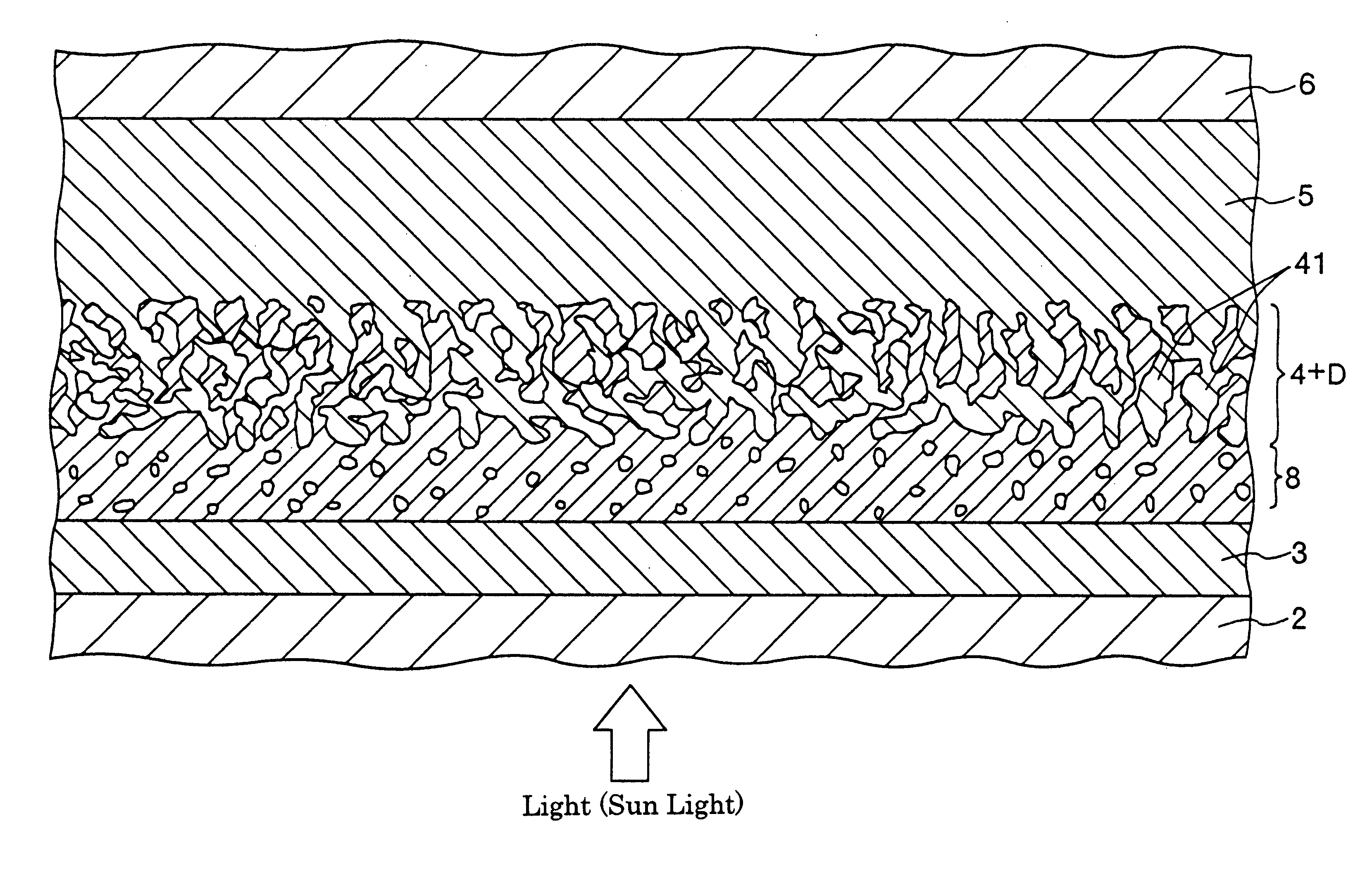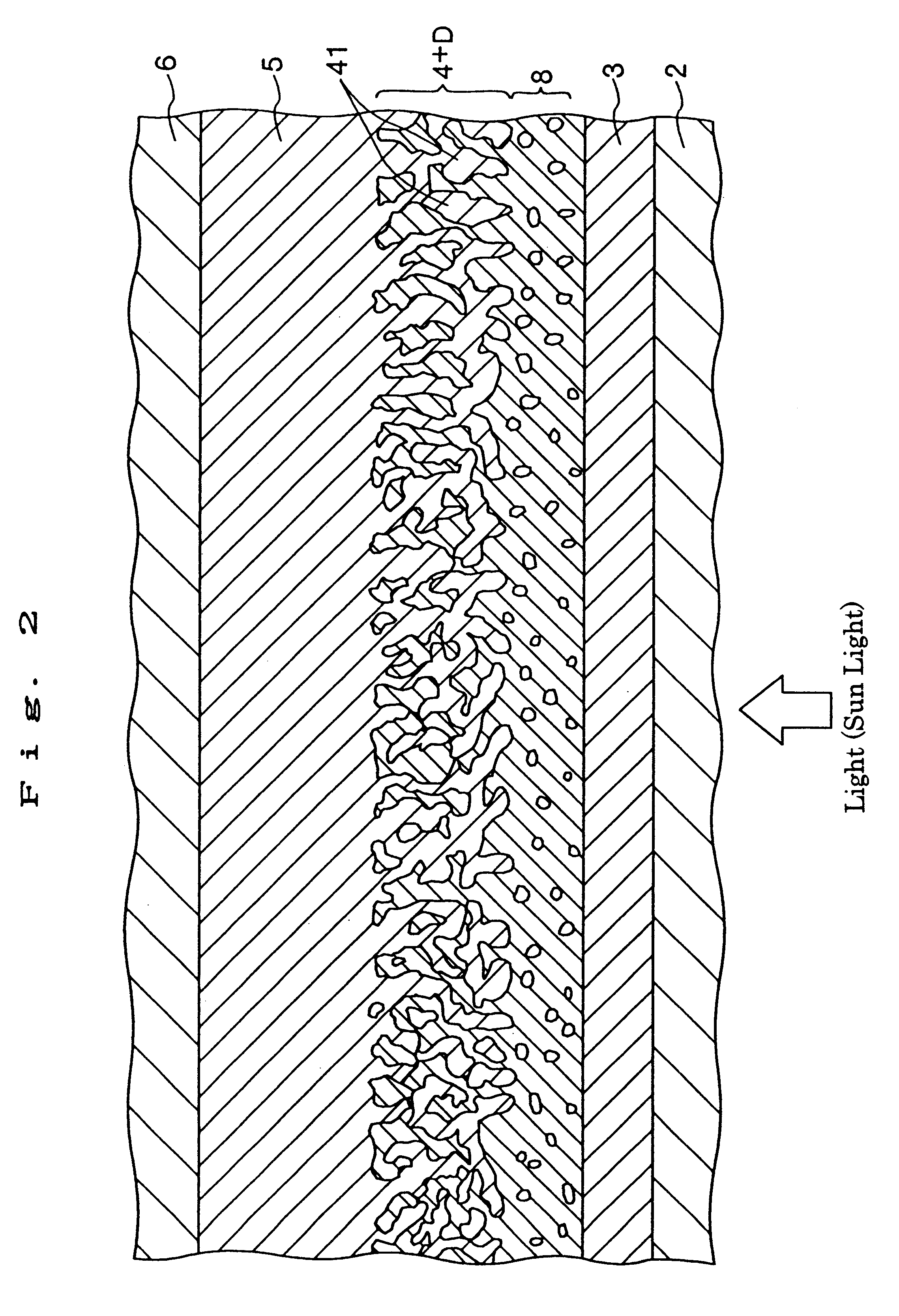Photoelectric conversion element
a conversion element and photoelectric technology, applied in the direction of thermoelectric devices, electrolytic capacitors, electrochemical generators, etc., can solve the problems of -type semiconductor layer prone to penetration, solar cell not yet established as energy-saving power source, electrolyte volatilization,
- Summary
- Abstract
- Description
- Claims
- Application Information
AI Technical Summary
Benefits of technology
Problems solved by technology
Method used
Image
Examples
example 1
A solar cell (photoelectric conversion element) shown in FIG. 1 was manufactured as follows.
(0) First, a soda glass substrate having the size of 30 mm (length).times.35 mm (width).times.1.0 mm (thickness) was prepared. Then, this soda glass substrate was subjected to cleaning by immersing it into a cleaning solution (a mixed solution of sulfuric acid and hydrogen peroxide to clean its surface.
(1) Next, an electrode made of FTO (first electrode) having the size of 30 mm (length).times.35 mm (width).times.1.0 mm (thickness) was formed on the top surface of the soda glass substrate by means of deposition.
(2) Next, a barrier layer was formed on the region of the FTO electrode having the size of 30 mm (length).times.30 mm (width). This barrier layer was formed as follows.
First, titanium tetraisopropoxide (organic titanium compound) was dissolved in an organic solvent of 2-n-butoxyethanol solution so that its concentration be 0.5 mol / L to obtain a solution.
Then, diethanolamine (additive) ...
example 2
A solar cell was manufactured in the same manner as the Example 1 excepting that the operation for forming the barrier layer was repeated twice using barrier layer materials of different compositions.
First, titanium tetrachloride (which is an inorganic titanium compound) was dissolved in ethanol anhydride so that its concentration be 1.0 mol / L.
In this way, a barrier layer material was obtained. In this case, the viscosity of the obtained barrier layer material was 0.9 cP (at a room temperature).
Further, the porosity of the obtained barrier layer was less than 1%, and the average thickness thereof was 2.1 .mu.m.
On the other hand, the porosity of the titanium oxide layer (electron transport layer) was 35%, and the average thickness thereof was 7.4 .mu.m.
Further, the resistance value in the thickness direction of the total of the barrier layer and the titanium oxide layer was equal to or greater than 1 k.OMEGA. / cm.sup.2.
example 3
A solar cell was manufactured in the same manner as the Example 1 excepting that the operation for forming the barrier layer was repeated for three times using barrier layer materials of different compositions.
First, titanium oxyacetonate (which is an organic titanium compound) was dissolved in 2-butanol so that its concentration be 1.5 mol / L.
In this way, a barrier layer material was obtained. In this case, the viscosity of the obtained barrier layer material was 1.3 cP (at a room temperature).
Further, the porosity of the obtained barrier layer was less than 1%, and the average thickness thereof was 3.1 .mu.m.
On the other hand, the porosity of the titanium oxide layer (electron transport layer) was 33%, and the average thickness thereof was 6.9 .mu.m.
Further, the resistance value in the thickness direction of the total of the barrier layer and the titanium oxide layer was equal to or greater than 1 k.OMEGA. / cm.sup.2.
PUM
| Property | Measurement | Unit |
|---|---|---|
| porosity | aaaaa | aaaaa |
| thickness | aaaaa | aaaaa |
| thickness | aaaaa | aaaaa |
Abstract
Description
Claims
Application Information
 Login to View More
Login to View More - R&D
- Intellectual Property
- Life Sciences
- Materials
- Tech Scout
- Unparalleled Data Quality
- Higher Quality Content
- 60% Fewer Hallucinations
Browse by: Latest US Patents, China's latest patents, Technical Efficacy Thesaurus, Application Domain, Technology Topic, Popular Technical Reports.
© 2025 PatSnap. All rights reserved.Legal|Privacy policy|Modern Slavery Act Transparency Statement|Sitemap|About US| Contact US: help@patsnap.com



